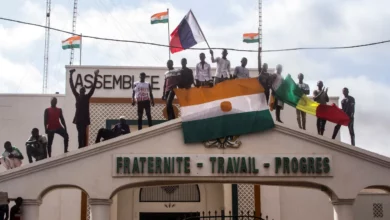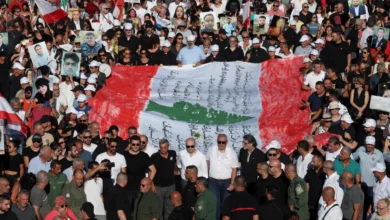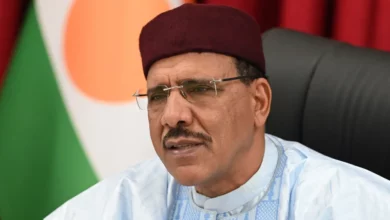
"You need to get a lot louder, because I can't hear you at all. Now, let's try it again: Hazem will rip out America's fangs!" His brow shiny with sweat, the man lowers his microphone and smiles broadly as the response comes — from the entire square, it seems. A few more rounds of call and response and the chant suddenly changes. For a few surreal moments, the only thing that can be heard in Tahrir is, "The people want Hazem Abu Ismail."
Abu Ismail is a former contestant in the presidential race whose recent disqualification by the Presidential Elections Commission has raised the tempers of his wide constituency.
The outskirts of the square are tightly guarded by a cordon of mostly bearded young men, their chests marked with the Muslim Brotherhood’s Freedom and Justice Party insignia. Immediately past them is Hazem territory, extending to a stage at the heart of the square. Across from it, a leafless tree bends under the weight of five megaphones. "Hazem is coming," the tree warns.
Snaking through the crowd is a procession of ten bearded youth, hoisting black flags that read "Mohamed is God's prophet" and "The Quran is our constitution." A young man runs up to them to take a picture. From his neck dangles a laminated card promoting the FJP's presidential candidate Mohamed Morsy, but carrying a picture of their excluded former frontrunner Khairat al-Shater.
Friday's protest was supposed to have been a gathering of liberal and secular forces, planned by the April 6 Youth Movement and the Revolutionary Youth Coalition, among others. The demand was mainly for the ruling military junta to return to the barracks in May as promised before and for the Presidential Elections Commission’s judicial immunity to be contested. In short, the protest was mainly aimed at reinstating public pressure against the ruling Supreme Council of the Armed Forces.
There had been widespread hopes that this Friday's gathering would be the unifying moment between a revolutionary front that, in the past year and a half, has become bitterly divided along ideological lines.
On the ground, however, this is all but apparent.
When the FJP announced it too would be participating in the protest, eyebrows were raised. The Islamist party, once the most popular of the nation's institutions, despite being outlawed, has seen its popularity plummet since their takeover of Parliament following last year's elections. A quest to dominate the Constituent Assembly tasked with writing the new constitution, their fielding of a presidential candidate despite previous vows against doing so and a general distance from street politics and the revolutionaries fed growing anti-Brotherhood sentiments. Some described their participation as either an attempt to reconcile with the street and the rest of the revolutionaries or a quest to expand their hegemony to the street, especially after the disqualification of Shater from the race and a growing rift with the ruling generals over power sharing.
They too have complaints against the SCAF, but this doesn't mean they are in unison with the rest of the revolutionary forces.
In the early afternoon hours of a liberal protest seeking to "reclaim the revolution," Tahrir Square had become an Abu Ismail fanclub — its members clearly elated at the turnout, and openly hostile to any ideological outsiders; easily defined by the absence of the bearded Salafi cleric's face on their attire.
At least one person is unhappy with the day's outcome. An elderly man slaps his palms together and shakes his head as he watches an Abu Ismail supporter continue to rile up the massive crowd. "What are we doing? What are those people doing?" he turns to ask this reporter. Not waiting for an answer, he turns around and addresses a large group of veiled women repeating the endless stream of pro-Hazem chants. "Is this what you wanted?" he asks one of them.
"Yes," she replies without hesitation. "I'm not ashamed to say I want what's right."
The old man gawks at her momentarily, and then pushes past this reporter, muttering, "Yeah, because Hazem started the revolution, didn't he, you dumb bitch."
A lonely island in a sea of Salafis, the National Coalition for Change stage boasts a handful of people, mostly in their early twenties. "We all remember Sayed Darwish and his beautiful lyrics," one youth bleats into the onstage microphone to a scattering of an audience (many of whom are wearing Abu Ismail badges and pins). "Here's one of his most beautiful songs, which we all know and love. It's called 'So It Goes.'" The youth begins to sing, but his voice is easily drowned out by the pro-Hazem stages on both sides. The small crowd disintegrates.
At ten past two, a wave of April 6 protesters march into the scene. They stop at Omar Makram Mosque to reorganize — "girls in the front with the banners, guys in the back with the flags," — as, a few meters ahead of them, the cordon of FJP security reinforces itself, its members either stone-faced or carrying a smile of bemusement. After a few false starts, the April 6 group moves forward, chanting "We will remain revolutionaries until we have freedom." A few of their number, males, break out ahead of the crowd and run into the FJP line, ordering them to let the procession through. With obvious reluctance, and few mocking remarks, the cordon opens up, and the 200 or so April 6 protesters enter the square, singing the first verse of the national anthem, which whimpers out due to apparent confusion regarding the lyrics.
"Look at them," a man in a galabeya and FJP badge smirks to his friend, as they watch the procession from the sidelines.
"I know," his friend replies.
Instead of moving through the square, the April 6 procession takes the shortest route to their stage, a wooden platform covered in signs that read "Religion is for God, the nation is for all," and similar slogans, which a few of the onstage members chant to their own small crowd.
Meanwhile, in the nearby suburb of Garden City, another April 6 procession winds through the quiet, tree-lined streets, chanting as loud as if they were in the heart of Tahrir. When asked what they were doing roaming empty streets and leaving the square to Abu Ismail supporters, one of the procession's leaders replied, "We're gathering people, and increasing our numbers."
Back in the square, political activist Ammar Ali Hassan is on the National Coalition for Change's stage, talking about the "dark tunnel" which the population is trapped in. A few feet from the stage, two men are having an argument.
"You can't say that Hazem pin you're wearing isn't propaganda," says one. "You can't say that chants like 'The people want Hazem' are part of what we're supposed to be doing here."
"This is not propaganda," the other replies, pulling at his pin. "Hazem is no longer a man, he has been elevated to an idea, and we support the idea."
"The idea of Hazem," the first man shouts. "Which makes no sense. I'm a lawyer, you know."
"So am I!" the second man roars.
"Where is the light?" Ammar Ali Hassan asks. His crowd stares blankly.
At the April 6 platform, one man, covered in the group's stickers, shouts on the phone, "Where are you? We need you now — you don't understand the numbers here, we're overwhelmed."
Off the phone, the man explains to Egypt Independent, "We're expecting more of us to show up, but they're running late trying to find reinforcements."
"This isn't over," he says. "You'll see."
When asked about the unity the day was supposed to bring, the man laughs. "Unity?" he throws his arms open, taking in his organization's stage and those beyond it. "This is it. We're all here, aren't we?"




